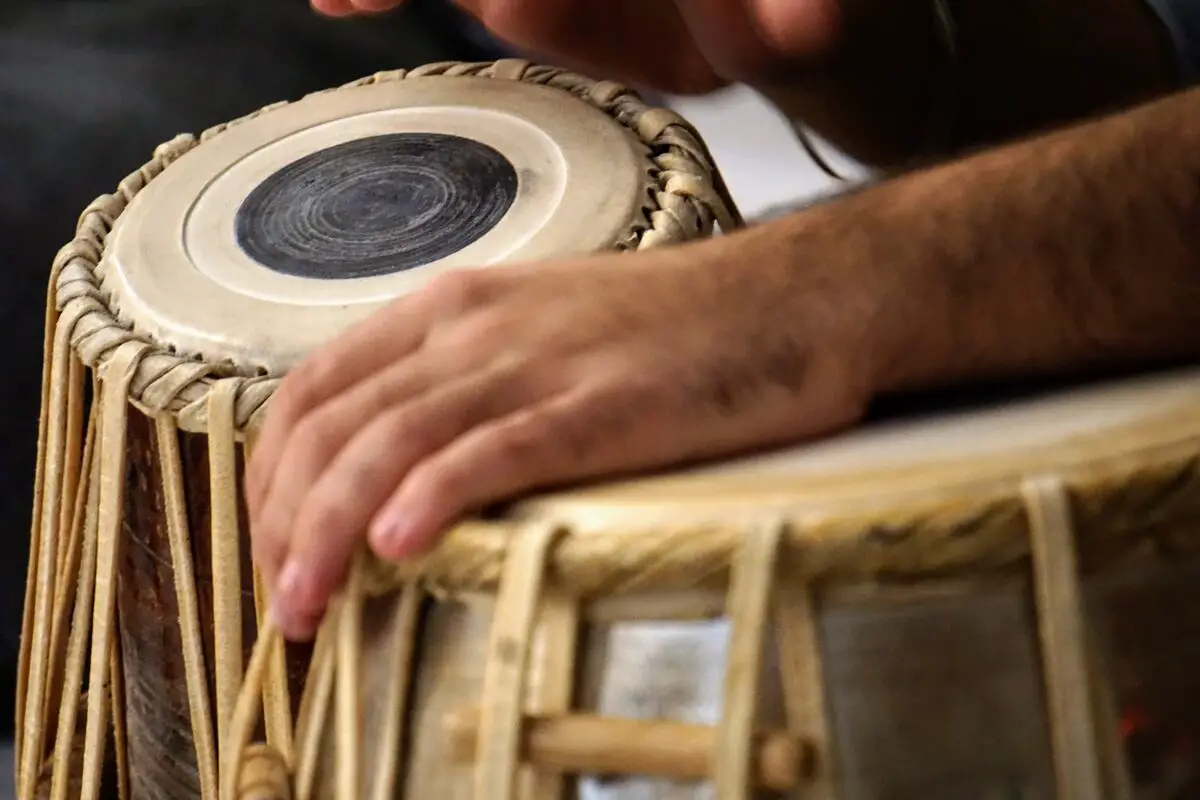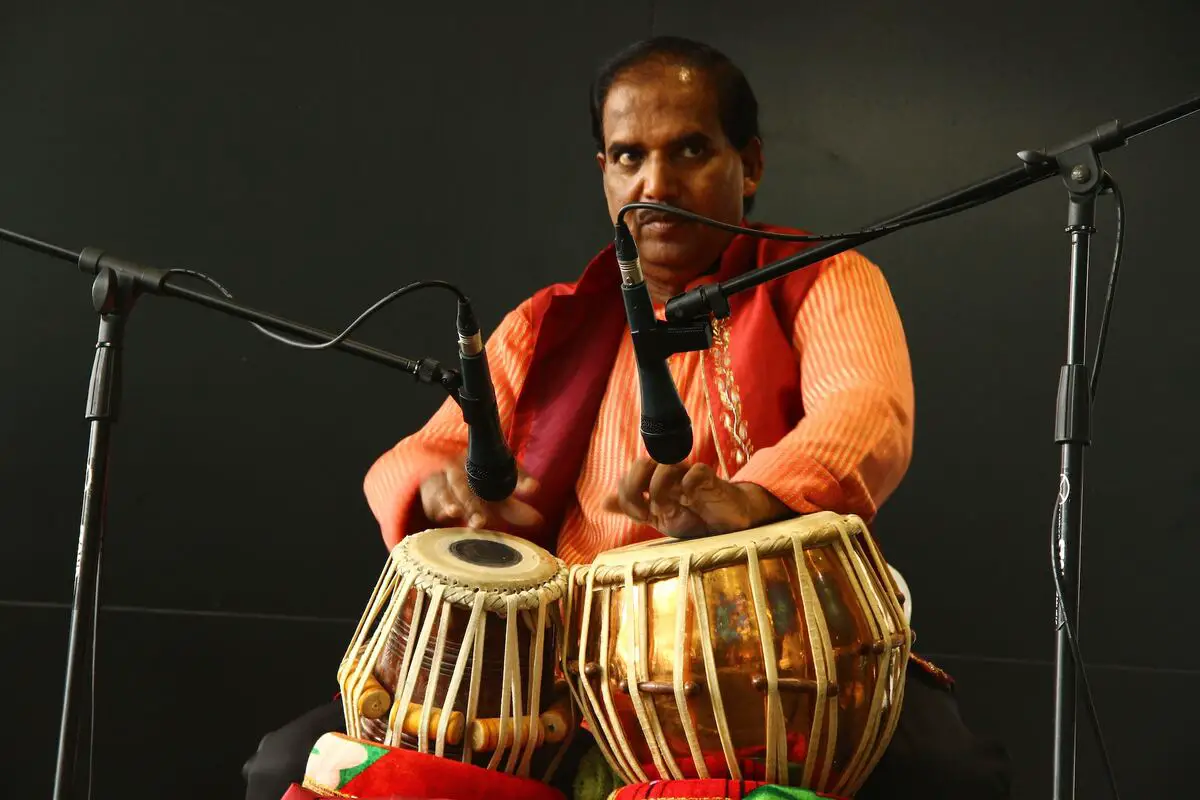Native to the Indian subcontinent, the tabla is not merely a tool for percussion but a storied vessel that carries centuries of tradition, technique, and musical exploration. With its distinctive timbre—ranging from the larger drum’s deep bass to the smaller one’s sharp tones—it is instrumental in both classical ragas and modern fusion genres. Are you ready to unlock the rhythmic wonders of the tabla? Hold on tight as we dive into the captivating world of India’s Queen of Drum and Percussion Instruments.
What is a tabla? The tabla is a pair of two drums originating from India, played with the hands. It is an essential percussion instrument in Indian Classical Music, showcasing improvisation, creativity, and mathematical patterns.
What is a tabla?
The tabla is a pair of drums originating from India. The ensemble consists of the Bayan (the larger bass drum) and the Dayan (the smaller drum). Played with the hands, tabla produces a mesmerizing range of sounds and rhythms. When combined, the two drums create an incredible fullness and detail in different rhythm structures that are unmatched by any other instrument.

AKAI Professional MPK Mini MK3

AKAI Professional MPK Mini MK3
What are the origins of the tabla?
The tabla, as we recognize it today, likely emerged between the late 1600s and the 1700s. It’s believed to have evolved in South Asia, drawing inspiration from various predecessor drums. This includes drums brought by Muslim invaders, like the naqqara, and indigenous drums such as the dholak, dhukkar or duggi, and the pakhawaj drum.
The earliest known mention of a tabla-like instrument was in 1810 by F. Baltazard Solvyns…
The exact origin of the tabla remains debated. Some argue its presence in pre-Islamic India, pointing to ancient stone carvings depicting upright hand drums. However, most scholars hesitate to accept these as definitive proof of the tabla’s ancient existence in India.
It’s worth noting that there are lack of documented references to tabla-like drums before the 19th century. The earliest known mention of a tabla-like instrument was in 1810 by F. Baltazard Solvyns, who described a “thobla” resembling today’s tabla. While the precise origins of the tabla remain elusive, the general belief is that the modern tabla developed in the Indian sub-continent, achieving its contemporary form around the 1700s.
What is the tabla’s significance in Indian Classical Music?
Indian Classical Music is a rich art form that has existed for thousands of years, and the tabla plays a vital role in this tradition. It is not just an accompaniment but also takes center stage in solos, symbolizing the importance of percussion in expressing musical emotions. Its improvisational nature allows tabla players to showcase their creativity by using mathematical patterns and logical variations to compose astonishing rhythms.
How is the tabla played and tuned?
Mastering the technique of playing the tabla requires extensive practice and differentiated fingering. The Bayan is played with the alternating index and middle fingers of the left hand, while the Dayan is played with the dominant hand. The tuning wedges and a woven ring around the skin allow for precise tuning, adjusting the pitch of the drums. The size of the Dayan, defined by the diameter of the skin, determines its sound. Smaller skins produce higher notes, while larger skins allow for lower tunings.

What types of wood are used to make tablas?
Various kinds of wood, including Shisham, Neem, Mahogany, and Babla Wood, are commonly used to craft tablas. Choosing the right wood is crucial for achieving consistent sound quality; however, the quality of the wood alone doesn’t determine the overall excellence of a tabla.
Factors such as the density of the wood, appropriate drying, and skilled craftsmanship also contribute to the instrument’s sound. It’s important to consult with experienced suppliers who can distinguish between good and substandard tablas.
With proper care, a tabla can last for many years. However, as with any instrument, maintenance and occasional repairs may be required. If the skin or a leather strap gets torn, spare parts are available for self-reheading or professional assistance can be sought. Regular cleaning and keeping the instrument in a controlled environment will help preserve its quality and performance.
If you want to see how the tabla is played, check out the video below.
Frequently Asked Questions (FAQs)
Got more questions about the captivating world of tabla? Check out these frequently asked questions!
How long does it take to master playing the tabla?
Mastering tabla playing technique and becoming proficient in compositions is a lifelong journey. It requires consistent practice, dedication, and guidance from experienced tabla teachers. Progression varies for each individual, but with regular practice and a passion for the instrument, you can develop a strong foundation and continue to enhance your skills over time.
Can the tabla be played with other instruments in a band setting?
Absolutely! The tabla is a versatile instrument that can be played alongside various other instruments in a band setting. Its rhythmic prowess allows it to blend beautifully with guitars, keyboards, violins, flutes, and more. Adding tabla to your band can bring a vibrant and dynamic element, elevating the overall musical experience.
Is it possible to create electronic tabla sounds for production purposes?
Yes, it is possible to create electronic tabla sounds for production purposes using software instruments and samples. Many music production software and virtual instrument plugins offer tabla samples and emulations that allow producers to incorporate tabla sounds into their tracks. This provides flexibility and convenience, especially in situations where a physical tabla may not be available or feasible.
Conclusion
Did I cover everything you wanted to know? Let me know in the comments section below. I read and reply to every comment. If you found this article helpful, share it with a friend, and check out my full blog for more tips and tricks on exploring the rhythmic wonders of tabla. Thanks for reading, and keep the beats flowing!
Key Takeaways
This article covered the tabla, India’s queen of drum and percussion instruments. Here are some key takeaways:
- Tabla consists of two drums: the Bayan and the Dayan.
- Tabla playing relies on intricate compositions and mathematical patterns.
- Different tabla styles and bols offer diverse rhythmic possibilities.
- Proper maintenance and care are necessary to ensure the longevity of the tabla.
- Tabla can be a versatile addition to music production and other genres.
- Learning tabla requires dedication and practice, but the journey is rewarding.















